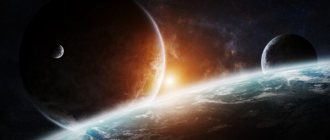Fact No. 1
The Sun is the Solar System as a whole. How can this be, because the system that is part of the galaxy is a system of planets, and the Sun is just a star, albeit the most central one. It would seem that the objects are completely different. Still, one has only to look at the Solar System in terms of its mass, and one can immediately see that the Sun occupies 98% of the total mass of the system in which humanity lives. The remaining 2% were divided to one degree or another by the 8 planets in the system, including the Earth. The lion's share of the mass is occupied by Jupiter and Saturn, the so-called “Gas Giants”. The Earth's share of the entire system accounts for an incredibly tiny mass by cosmic standards.
What is the Sun made of?
In terms of its chemical composition, our luminary is no different from other stars and contains: 74.5% hydrogen (by mass), 24.6% helium, less than 1% other substances (nitrogen, oxygen, carbon, nickel, iron, silicon, chromium, magnesium and other substances). Inside the core there are continuous nuclear reactions that convert hydrogen into helium. The absolute majority of the mass of the Solar System - 99.87% belongs to the Sun.
Composition of the Sun
Interesting fact : The Sun has an almost perfect spherical shape. The difference in diameters connecting opposite points of the equator and poles is 10 kilometers. And this despite its gigantic size!
Fact No. 6
The sun is a multi-layered star. The visible surface of a star is only its outer layer. It is called the photosphere. The temperature on it can reach 5700 Kelvin or 15561000C, because one Kelvin is equal to 2730C.
Then, at around 70% of the solar diameter, there is a layer called “convection”. Next is a zone called "Radiant Transfer". The center of the star is the nucleus. Its temperature reaches values of at least 16,000,0000C. It now becomes clear that the solar surface is not the hottest place not only on the star, but also in the solar system as a whole.
Characteristics of the Sun
The sun has the following parameters:
- Age –4.57 billion years;
- Distance to Earth: 149,600,000 km
- Mass: 332,982 Earth masses (1.9891·10³⁰ kg);
- The average density is 1.41 g/cm³ (it increases 100 times from the periphery to the center);
- The orbital speed of the Sun is 217 km/s;
- Rotation speed: 1.997 km/s
- Radius: 695-696 thousand km;
- Temperature: from 5,778 K at the surface to 15,700,000 K at the core;
- Corona temperature: ~1,500,000 K;
- The Sun is stable in its brightness, it is in the 15% of the brightest stars in our Galaxy. It emits less ultraviolet rays, but has more mass compared to similar stars.
Fact No. 7
For centuries, religion refused to acknowledge the rotation of our planet around the sun. Religious leaders and their followers considered our planet to be the center of all things. It got to the point that in 1633, a physicist named Galileo Galilei was condemned for his public support of the system of the universe put forward by Nicolaus Copernicus, who argued that the planet revolved around a star. The church considered this theory to be a theory of heretics since 1616. As a result, Galileo was imprisoned for life. Later, they took pity on him, and life imprisonment was replaced by house arrest, but under the tireless eye of the Inquisition.
The church openly acknowledged that the Earth rotates around the sun in 1992. This was done by none other than the famous John Paul II. The Pope went further and admitted that Galileo's trial was wrong, calling it a "tragic misunderstanding."
Why does the sun shine?
Many philosophers and scientists have tried to answer this seemingly simple question. The ancient Greek astronomer Anaxagoras managed to go to prison for his theory of a red-hot metal ball. Clarity came with the beginning of the 20th century and the discovery of the phenomenon of radioactivity, and then the possibility of conducting controlled nuclear and thermonuclear reactions.
It was these discoveries that lifted the veil of mystery about the origin of the most common natural phenomenon. English scientists Ernest Rutherford and Arthur Eddington were the first to suggest that thermonuclear fusion reactions occur in the depths of our star. Thanks to this, the Sun's hydrogen gradually turns into helium, releasing streams of photons that we observe as light.
Ernest Rutherford
Interesting fact : the color of our star is pure white, due to the passage of layers of the earth’s atmosphere we see it: yellow, red, orange.
Fact No. 10
The existence of life on Earth is impossible without solar heat and light. However, if we imagine that the Sun will stop giving heat, then first of all, in just one week the temperature on the surface of our planet will drop to -180C. Only a year will pass and the surface of the Earth will be stable at -730C. But that’s not all, because the temperature will not stop dropping, which will certainly result in the death of all forms of life on the planet and the onset of permafrost.
Solar eclipse
An event such as a solar eclipse has always evoked a range of feelings among ignorant people, accompanied by horror and panic. There were also those who wanted to “warm their hands on this” and earn the authority of predictors and clairvoyants. But not only thinking creatures, but also animals react to the appearance of darkness. However, for the most part, they perceive it as the onset of night.
Interesting: The speed of light - briefly, photos and videos
Solar eclipse - diagrams
The scientific explanation for the phenomenon is simple: the Moon covers the Sun. This happens only during the new moon (the approximate location of all three celestial objects on the same line, and even then not always). Types of solar eclipses from the perspective of an earthly observer:
- “Private” – the satellite partially covers the star.
- “Full” – the solar disk is completely closed.
- “Ring-shaped” - the cone of the cast shadow does not reach the earth’s surface.
- “Total annular” or “hybrid” - two observers at different points simultaneously see one of the types of solar eclipses.
Solar eclipse
Observation of this phenomenon allowed us to make a number of important discoveries and examine the corona and atmosphere of the Sun. Which under normal conditions is extremely difficult. By the way, the spectacle itself does not spoil earthlings with the frequency of its appearance. The frequency of occurrence of the event is: 237 times per century.
Fact No. 12
There is no larger object than the Sun in our galactic system. To understand the size of the star, you just have to imagine that if you filled all the space it occupies with planets like the Earth, then the star would accommodate at least 960,000 of them! And this is only if you place spherical planets in the Sun. If oblate variants of planets are placed in the star, 1,300,000 planets similar to the one on which people live will be able to fill the space occupied by the Sun. In terms of area, the surface of the sun is 11,900 times larger compared to the same indicator of the Earth.
Summary of an ecology lesson on the topic “The importance of the sun in our lives”
For middle group children
Program content. To draw children's attention to the constant presence of the sun, warmth, light in our human lives, to evoke an emotional attitude towards the sun, to its role in the life of humans, birds and animals. To acquaint children with the behavioral and visual characteristics of animals living in conditions of lack of light or in the complete absence of light. Give first ideas about environmental protection.
Material and equipment. A thick blanket, a painted sun, a figurine of a person, a table lamp, a bag with various dry herbs, various small objects, mirrors for each child, musical accompaniment.
Progress of the lesson.
What is the weather today: sunny or cloudy. Is the sun shining? What mood do children have in sunny weather and what in cloudy weather? Psycho-gymnastics “Sunny - Cloudy” is carried out
Why do we need the sun? What does it do for us? /warms, shines/. Where does the sun go in the evening? What do we do at night? Where does the sun come from in the morning? /wakes up/.
Game "Day - Night". At the teacher’s command, it’s night / the children fall asleep /, at the command of day, they wake up.
What would happen if the sun went to sleep and never returned? /frozen/. Psycho-gymnastics “Cold”.
To feel how we would live without sunlight, we need to be in complete darkness. To play, take a thick blanket, children sit on the floor and cover themselves with the blanket. What do they see? Day comes, the blanket is removed, and sunlight helps children distinguish objects. Why couldn't children see, because they have eyes? A person sees when he has light. If there were no light, then we would not need eyes.
How does the sun get through our window? That he has? /rays/. Do you want to play with a ray of sunshine? How can you play with the beam? You can catch him. How? /mirror/. The teacher catches a ray of sunshine with a mirror, invites the children to catch the ray, /what is a ray of sunshine?/ what is a sunbeam? A ray of sunshine is reflected from the mirror and turns into a sunbeam. The game “sun bunnies” children turn into sun bunnies and flutter like sun bunnies to the accompaniment of music.
Who else besides humans needs the sun? /animals/, Why? But there are animals that see in the dark. Who is this? /cat, owl/, How do they hunt? Game "Animals in the Dark". The child is blindfolded, the teacher gives an object into his hands and asks him to guess what exactly he received. It is advisable for the item to have a scent, /it can be dried grass, fresh pine cone, lemon or apple/. Being in the dark, the child will try to blindly identify the proposed object. How will he do this? Touch the object with your hands, stroke it, turn it, smell it.
After the children identify objects in the dark, the teacher discusses with them how they did it. Did they need eyes? But there are animals that live where there is practically no light. For example: underground in deep caves, at the bottom of the ocean. Indeed, their eyes turn into small slits /mole/.
Who else needs sunlight? /plants/. What happens if a plant falls into complete darkness? /will die/. The teacher demonstrates a plant that grew in the dark and a plant that grew in the light. Children find the difference in the color of the plant. They draw a conclusion.
Where can the sun go? /night, cloud, smoke/. What should we do to prevent the sun from disappearing? /children answer/. In the meantime, we are friends with the sun.
Psycho-gymnastics “Solar warmth” is carried out. To the accompaniment of calm music, children expose their faces to the sun, close their eyes, and relax.
In order for children to clearly understand how the sun is covered by a cloud and a shadow falls on a person, an experiment is carried out. Take a burning table lamp, a small man, and insert a flat circle between them. A shadow appears on a person.
How did the Sun come into being?
There are different theories about the origin of the Sun. The most popular of them claims that the star was formed from a cloud of gas and dust that arose as a result of a supernova. As evidence, the argument is given that there is a large amount of uranium and gold in the central body of our star system.
Interesting fact: the radius of the Sun is 2100 times smaller than the radius of UY Scuti - the largest open star in the Universe.
Another hypothesis traces a long chain of transformations: a comet from the periphery of the Galaxy -> ice planet -> giant planet -> infrared dwarf -> yellow dwarf. By accumulating mass, the Sun, under the influence of gravitational forces, increased the density of the core to the point of launching thermonuclear reactions, and the possibility of retaining the atmosphere. Moreover, the attraction of the huge ball made it possible not to let go of even light gases: hydrogen and helium. True, from the surface of the star, they still evaporate into outer space.
Formation of the Solar System
There are several stars - analogues of the Sun in the constellations: Gemini, Scorpio, Canes Venatici, Poop, Draco. Their luminosity, temperature, mass, density and approximate age coincide with our star.
An interesting fact: the prospects for the evolution of the Sun are such that one day it will burn and devour the Earth (red giant), and then itself will take its size (white dwarf).
Life cycle of the Sun
Apparently, the Sun owes its appearance to protostars of previous generations, since it contains a significant amount of metals. Its age is 4.5 -4.75 billion years, and all this time it increases its brightness and temperature (flares up).
Life cycle of stars
Interesting fact: the magnetic field of our star has a cycle of change approximately equal to 22 Earth years. Which is equal to two periods of solar activity in 11 years.
Such a physical process cannot occur without loss of mass of hydrogen, which is the main element in the composition of the star. Someday this will end, the hydrogen will burn and evaporate, and the helium will begin to shrink. The size of the star will increase until it reaches the limits of the Earth's orbit. The Sun will become a red giant and will remain in this state for approximately 120 million years. Then a nebula will appear due to a significant decrease in mass and a gigantic expansion of the outer layer. It will change from a red giant to a white dwarf, which will turn black in a few trillion years.
Interesting: Solar system - what it is, composition, planets in order, structure, photos and videos
Vladimir Soloukhin - The sun was setting in Zhuravlikha
The sun was setting in Zhuravlikha, the distant bushes were going to bed, and the copper crosses were going out in the small and quiet church.
And then from a distant ravine, following a herd of slow cows, the blue of July evenings floated out, dark as mash.
The forest turned black with a jagged edge In the gold of the sunset strip, And the flower left by the bee grew heavy under the drops of dew.
Inviting me to fairy-tale lands, an owl hooted behind the village, and they sent me, a boy, too early to sleep in the hayloft.
I watched, without immediately falling asleep, how a star moved in the crack, how the moon pulled the wires through the holes of the blue barn.
At this hour, usually over the river, Solovyov in the wilderness surroundings, Someone's restless soul was scattered with dashing music.
“Eh, girl, clear dawn, come out to meet me - I’ll love you! Boyfriend, maple club, don’t go to the girl - I’ll ruin you!”
And almost until dawn, excess strength, violence and fire, this slightly intoxicating, menacing accordion reigned over the area.
But one day, somewhere in the distance, Where the sublunar grass sleeps, Quiet, unheard singing began to sound, timid at first,
And then it flowed more solemnly and higher To the sky, to the stars, to the heart... In my life I have heard many violins, And great violins, I had the opportunity.
But I no longer heard such a thing, as if from the moon itself Music arose and, rejoicing, Floated over the quiet land,
The White cherry orchards sounded like a quiet song... And from this audacity at first the formidable frets fell silent.
Well, after that, as soon as evening falls, there is an abundance of strength, violence and fire, A slightly intoxicated, menacing accordion was moving towards a new song.
And, afraid to get closer, she must have walked around in bass voices, And joyful, both of these voices merged into a duel.
The July nights passed, fine, And in the harmony, which had gone astray, Something different appeared, Trembling, almost timid.
The more the violin rejoiced and called, alarming and beckoning. There was a lot of sadness in the songs, There was a lot of power and fire.
And then these sounds fell silent, my debaters fell silent, and then the marvelous nightingales struck in the area with renewed force.
The night twinkled like a blue star, Roosters crowed in the distance. How could I have seen from the hayloft, How the lovers passed through the boundary,
How, protecting from the morning cold, - You know, the soul is really hot - A guy wrapped a girl from the city in his jacket from a hot shoulder.











